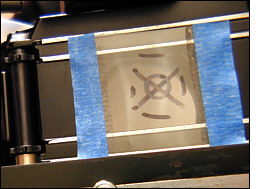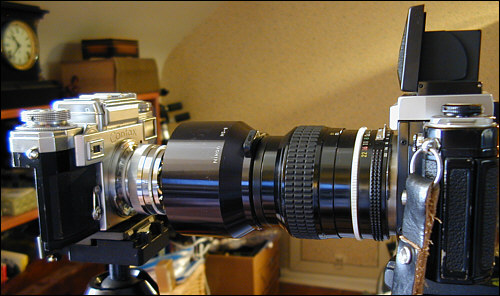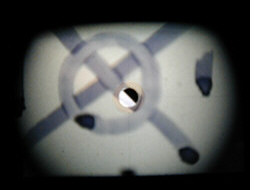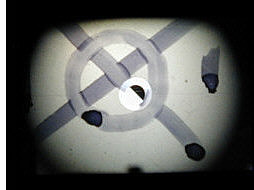
Collimating your lens
Collimating your lens is one of the simpler things you can do. That
means, ensuring the lens is dead-on at infinity. Here's what you'll need:
- An SLR, preferably with a waist-level finder, though it's not a
necessity
- A telephoto lens for the SLR – at least 85mm
- Two tripods
- A cable release to lock the shutter open
- A small piece of glass or plastic, a marker, some tape
 |
Specific notes for the 50mm Sonnar lens
The 50mm Sonnar for the Zeiss Ikon Contax rangefinder doesn't have its own helical.
It's built into the body.
The postwar lenses use a small
collar (marked by the yellow pointer) that surrounds the inner lens
assembly. Rotating the lens collar moves the lens toward or away from
the film plane. Keep in mind that tightening the rear retaining ring
pulls the lens into the outer barrel, so you need to fully tighten the
rear retaining ring to ensure that you are precise when collimating the
lens.
To disassemble the Sonnar for
collimating, simply remove the rear outer collar, and the primary lens
assembly should slide out from the front. Don't lose the small plug
inside the barrel. It fits inside the U channel (circled in yellow). Leave
out the plug while collimating the lens and replace after infinity focus
is set. |
|
|
 STEP ONE: Create
your target. You can use a small piece of flat plastic or some tape that
is stretched taut across the film gate. Then draw a design or "x" or
something on it. STEP ONE: Create
your target. You can use a small piece of flat plastic or some tape that
is stretched taut across the film gate. Then draw a design or "x" or
something on it.I do quite a bit of these, so I have two targets: One
for 35mm and another for medium format.
With tape, it's so thin that you can make your mark on the back side.
With the thicker plastic, the marks I've made are on the "emulsion"
side.
|
|
|

.jpg)
|
| STEP TWO: Aim the two
cameras at each other. The lenses should be at the same height, and the
cameras should be as level as reasonably possible. The idea is to get
the film planes of both cameras to be parallel. The distance between the
cameras has no bearing. Select something that makes it easy for you. Here, I
am using a 105mm lens with a hood. The hood is nice to block out
extraneous light, though it's not necessary even though every little bit helps.
Important: Open both lenses to the maximum aperture and make sure
both are set to infinity. On the target camera, set the shutter to "B"
and lock it open with a cable release, if necessary. Or you can use "T,"
if that's available. |
|
|

|
 |
STEP THREE: While peering through the viewfinder, you will rotate
either the front element, if it's a front-cell focusing lens, or the
entire lens within its mount until the target is in focus. Do not move
the focusing ring of either camera. The Sonnar requires you to
rotate the collar and assemble the lens before checking infinity focus. You might
want to get it as close as possible without a full reassembly. Then once
you are within a quarter turn or so, test with a full reassembly.This is where the waist-level
finder comes in handy, because you can peer into the finder while
manipulating the lens on the target camera. This finder also has a
pop-up magnifying glass, which is a big help when doing this. Use
the ground glass, rather than the split-image. Out of focus is on the
left, in focus is on the right. Once infinity focus is set, you can
reassemble the lens. Obviously, do not rotate the lens within its mount
or the front cell until it's
reassembled. You should make a final check after reassembly. |
|
|
Final note: This works best when you have a bright light
source. I almost always do this during the day with the back of the target
camera facing an open window.
|
|
 |
|